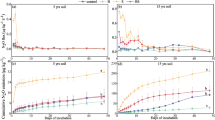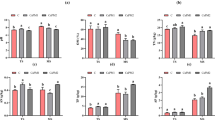Abstract
Pig manure (PM) is widely used as an organic fertilizer to increase yields of crops. Excessive application of compost containing relatively great concentrations of copper (Cu) and zinc (Zn) can change soil quality. To clarify the effects of different rates of application and to determine the optimal rate of fertilization, PM containing 1,115 mg Cu kg−1, dry mass (dm) and 1,497 mg Zn kg−1, dm was applied to alkaline soil at rates of 0, 11, 22, 44, 88, and 222 g PM kg−1, dm. Phospholipid fatty acids (PLFAs) were used to assess soil microbial community composition. Application of PM resulted in greater concentrations of total nitrogen (TN), NH4 +-N, NO3 −-N, total carbon (TC), soil organic matter (SOM) but lesser pH values. Soils with application rates of 88–222 g PM kg−1, dm had concentrations of total and EDTA-extractable Cu and Zn significantly greater than those in soil without PM, and concentrations of T-Cu and T-Zn in these amended soils exceeded maximum limits set by standards in china. Except in the soil with a rate of 11 g PM kg−1, dm, total bacterial and fungal PLFAs were directly proportional to rate of application of PM. Biomasses of bacteria and fungi were significantly greater in soils with application rates of 44–222 g PM kg−1, dm than in the soil without PM. SOM, TC and EDTA-Zn had the most direct influence on soil microbial communities. To improve fertility of soils and maintain quality of soil, rate of application should be 22–44 g PM kg−1 dm, soil containing Cu and Zn.


Similar content being viewed by others
References
Al Chami, Z., Cavoski, I., Mondelli, D., & Miano, T. (2013). Effect of compost and manure amendments on zinc soil speciation, plant content, and translocation in an artificially contaminated soil. Environmental Science and Pollution Research, 20, 4766–4776.
Anderson, I. C., Parkin, P. I., & Campbell, C. D. (2008). DNA- and RNA-derived assessments of fungal community composition in soil amended with sewage sludge rich in cadmium, copper and zinc. Soil Biology and Biochemistry, 40, 2358–2365.
Angers, D. A., Chantigny, M. H., MacDonald, J. D., Rochette, P., & Cǒté, D. (2010). Differential retention of carbon, nitrogen and phosphorus in grassland soil profiles with long-term manure application. Nutrient Cycling in Agroecosystems, 86, 225–229.
Atafar, Z., Mesdaghinia, A., Nouri, J., Homaee, M., Yunesian, M., Ahmadimoghaddam, M., & Mahvi, A. H. (2010). Effect of fertilizer application on soil heavy metal concentration. Environmental Monitoring and Assessment, 160, 83–89.
Azarbad, H., Niklińska, M., van Gestel, C. A., van Straalen, N. M., Röling, W. F., & Laskowski, R. (2013). Microbial community structure and functioning along metal pollution gradients. Environmental Toxicology and Chemistry, 32, 1992–2002.
Baker, L. R., White, P. M., & Pierzynski, G. M. (2011). Changes in microbial properties after manure, lime, and bentonite application to a heavy metal-contaminated mine waste. Applied Soil Ecology, 48, 1–10.
Bhattacharyya, P., Tripathy, S., Chakrabarti, K., Chakraborty, A., & Banik, P. (2008). Fractionation and bioavailability of metals and their impacts on microbial properties in sewage irrigated soil. Chemosphere, 72, 543–550.
Bremner, J. M. (1965). Methods of soil analysis. Madison, WI: American Society of Agronomy.
Cao, Y., Chang, Z., Wang, J., Ma, Y., & Fu, G. (2013). The fate of antagonistic microorganisms and antimicrobial substances during anaerobic digestion of pig and dairy manure. Bioresource Technology, 136, 664–671.
Chen, T. B., Zheng, Y. M., Chen, H., & Zheng, G. D. (2004). Background concentrations of soil heavy metals in Beijing. Environmental Sciences, 25, 117–112.
Chodak, M., Gołębiewski, M., Morawska-Płoskonka, J., Kuduk, K., & Niklińska, M. (2013). Diversity of microorganisms from forest soils differently polluted with heavy metals. Applied Soil Ecology, 64, 7–14.
Cook, B. D., & Allan, D. L. (1992). Dissolved organic carbon in old field soils: total amounts as a measure of available resources for soil mineralization. Soil Biology & Biochemistry, 24, 585–594.
de Vries, F. T., Hoffland, E., van Eekeren, N., Brussaard, L., & Bloem, J. (2006). Fungal/bacterial ratios in grasslands with contrasting nitrogen management. Soil Biology and Biochemistry, 38, 2092–2103.
Duan, G., Zhang, H., Liu, Y., Jia, Y., Hu, Y., & Cheng, W. (2012). Long-term fertilization with pig-biogas residues results in heavy metal accumulation in paddy field and rice grains in Jiaxing of China. Soil Science and Plant Nutrition, 58, 637–646.
Duarte, S., Pascoal, C., Alves, A., Correia, A., & Cassio, F. (2008). Copper and zinc mixtures induce shifts in microbial communities and reduce leaf litter decomposition in streams. Freshwater Biology, 53, 91–101.
Fan, J., Ding, W., & Ziadi, N. (2013). Thirty-year manuring and fertilization effects on heavy metals in black soil and soil aggregates in northeastern China. Communications in Soil Science and Plant Analysis, 44, 1224–1241.
Fernández-Calviño, D., Martín, A., Arias-Estévez, M., Bååth, E., & Díaz-Raviña, M. (2010). Microbial community structure of vineyard soils with different pH and copper content. Applied Soil Ecology, 46, 276–282.
Frostegård, A., & Bååth, E. (1996). The use of phospholipid fatty acid analysis to estimate bacterial and fungal biomass in soil. Biology and Fertility of Soils, 22, 59–65.
Hammesfahr, U., Heuer, H., Manzke, B., Smalla, K., & Thiele-Bruhn, S. (2008). Impact of the antibiotic sulfadiazine and pig manure on the microbial community structure in agricultural soils. Soil Biology and Biochemistry, 40, 1583–1591.
Hinojosa, M. B., Garcia-Ruiz, R., & Carreira, J. A. (2010). Utilizing microbial community structure and function to evaluate the health of heavy metal polluted soils. Soil Heavy Metals, 19, 185–224.
Huang, Z. P., Xu, B., & Tu, D. Y. (2007). Organic substrate change in the swine manure-applied vegetable soils. Journal of Anhui Agricultural University, 34, 262–264.
Huang, D. F., Li, W. H., & Wang, L. M. (2014). Study on water and fertilizer managements and evaluation of nitrogen and phosphorus non-point source pollution from paddy field. Image Processing for Cinema, 4, 335.
Jacela, J. Y., DeRouchey, J. M., Tokach, M. D., Goodband, R. D., Nelssen, J. L., & Renter, D. G. (2012). Feed additives for swine: fact sheets—high dietary levels of copper and zinc for young pigs, and phytase. Journal of Swine Health and Production, 18, 87–91.
Krishnamurti, G. S., Subashchandrabose, S. R., Megharaj, M., & Naidu, R. (2013). Assessment of bioavailability of heavy metal pollutants using soil isolates of Chlorella sp. Environmental Science and Pollution Research, 1–7.
Lee, C. H., Wu, M. Y., Asio, V. B., & Chen, Z. S. (2006). Using a soil quality index to assess the effects of applying swine manure compost on soil quality under a crop rotation system in Taiwan. Soil Science, 171, 210–222.
Li, G. C., Wang, Y. P., & Chang, J. M. (1987). Publication by the Environmental Protection Administration (EPA) of Taiwan. Taipei: Taiwan. Heavy metal concentrations in soils of Taiwan.
Lichtfouse, E. (2009). Organic farming, pest control and remediation of soil pollutant. Dijon, France: Springer.
Mackie, K., Müller, T., Zikeli, S., & Kandeler, E. (2013). Long-term copper application in an organic vineyard modifies spatial distribution of soil micro-organisms. Soil Biology and Biochemistry, 65, 245–253.
Meng, J., Wang, L., Liu, X., Wu, J., Brookes, P. C., & Xu, J. (2013). Physicochemical properties of biochar produced from aerobically composted swine manure and its potential use as an environmental amendment. Bioresource Technology, 142, 641–646.
Park, J. H., Lamb, D., Paneerselvam, P., Choppala, G., Bolan, N., & Chungd, J. W. (2010). Role of organic amendments on enhanced bioremediation of heavy metal(loid) contaminated soils. Journal of Hazardous Materials, 185, 549–574.
Rees, H., Chow, L., Zebarth, B., Xing, Z., Toner, P., & Lavoie, J. (2013). Impact of supplemental poultry manure application on potato yield and soil properties on a loam soil in north western New Brunswick. Canadian Journal of Soil Science, 94, 1–17.
Shi, J. C., Yu, X. L., Zhang, M. K., Lu, S. G., Wu, W. H., Wu, J. J., & Xu, J. M. (2011). Potential risks of copper, zinc, and cadmium pollution due to pig manure application in a soil–rice system under intensive farming: a case study of Nanhu, China. Journal of Environmental Quality, 40, 1695–1704.
Thu, T. D., Jusselme, D. M., Lata, J. C., Van Nguyen, B., & Jouquet, P. (2013). The earthworm species Metaphire posthuma modulates the effect of organic amendments (compost vs. vermicompost from buffalo manure) on soil microbial properties. A laboratory experiment. European Journal of Soil Biology, 59, 15–21.
Wakelin, S. A., Chu, G. X., Broos, K., Clarke, K. R., Liang, Y. C., & McLaughlin, M. J. (2010). Structural and functional response of soil microbiota to addition of plant substrate are moderated by soil Cu levels. Biology and Fertility of Soils, 46, 333–342.
Wei, F. S., Chen, J. S., Wu, Y. Y., & Zheng, C. J. (1991). Study on the background contents on 61 elements of soil in China. Environmental Sciences, 12, 12–20.
Wu, L. H., Tan, C. Y., Liu, L., Zhu, P., Peng, C., Luo, Y. M., & Christie, P. (2012). Cadmium bioavailability in surface soils receiving long-term applications of inorganic fertilizers and pig manure. Geoderma, 173, 224–230.
Xiong, X., Li, Y., Li, W., Lin, C., Han, W., & Yang, M. (2010). Copper content in animal manures and potential risk of soil copper pollution with animal manure use in agriculture. Resources, Conservation and Recycling, 54, 985–990.
Zelles, L. (1999). Fatty acid patterns of phospholipids and lipopolysaccharides in the characterisation of microbial communities in soil: a review. Biology and Fertility of Soils, 29, 111–129.
Zhang, Q. C., Shamsi, I. H., Xu, D. T., Wang, G. H., Lin, X. Y., Jilani, G., Hussainc, N., & Chaudhry, A. N. (2012). Chemical fertilizer and organic manure inputs in soil exhibit a vice versa pattern of microbial community structure. Applied Soil Ecology, 57, 1–8.
Acknowledgements
This work was supported by grants from the Natural Science Foundation of China (Nos. 41271502 and C031001), Strategic Priority Research Program of the Chinese Academy of Sciences, Grant No. XDB03030504, the Special Program for Basic Science and Technology under Grant No. 2013FY111100. Portions of the research were supported by a Discovery Grant from the National Science and Engineering Research Council of Canada (Project No. 6807. Prof. Giesy’s participation in the project was supported as an at-large Chair Professorship from the City University of Hong Kong and by an "Area of Excellence" Grant (AoE P-04/04) from the Hong Kong Grants Council, the Einstein Professor Program of the Chinese Academy of Sciences.
Author information
Authors and Affiliations
Corresponding author
Rights and permissions
About this article
Cite this article
Zhang, Y., Luo, W., Jia, J. et al. Effects of pig manure containing copper and zinc on microbial community assessed via phospholipids in soils. Environ Monit Assess 186, 5297–5306 (2014). https://doi.org/10.1007/s10661-014-3778-6
Received:
Accepted:
Published:
Issue Date:
DOI: https://doi.org/10.1007/s10661-014-3778-6




